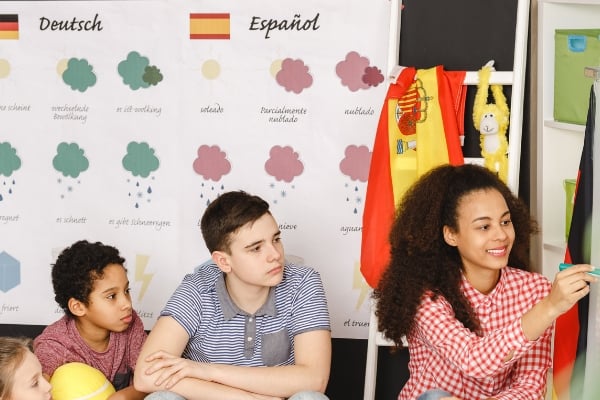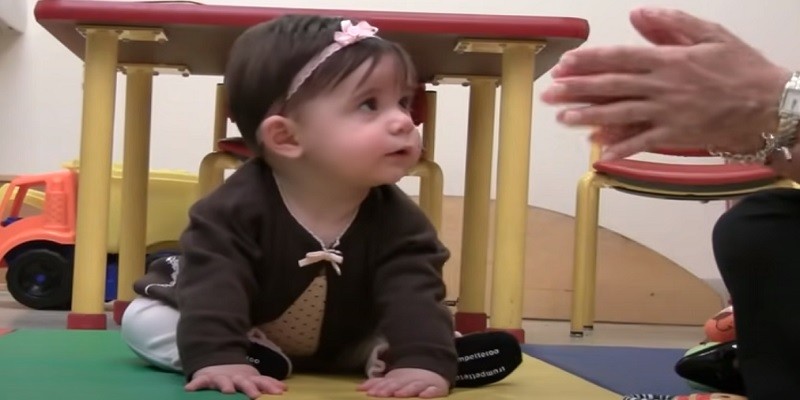Spanish is the easiest language for a child to learn due to its Latin roots, identical alphabet, and straightforward pronunciation rules. Learning Spanish at an early age can also pave the way for future learning of other Latin-based languages such as French and Italian.

Credit: www.unitedlanguagegroup.com
Spanish: A Latin-based Language With Similarities To English
Spanish, a Latin-based language with similarities to English, is considered one of the easiest languages for a child to learn. The shared alphabet and pronunciation rules between English and Spanish make it an accessible language, and learning Spanish at an early age can pave the way for future mastery of other Latin-based languages.
Latin Roots Make Spanish One Of The Easiest Languages For English Speakers To Learn
Spanish is a Latin-based language with strong roots in Latin grammar and vocabulary. Due to this connection, Spanish shares many similarities with English, making it one of the easiest foreign languages for English speakers to learn. The Latin influence on Spanish allows for easier comprehension and recognition of words and sentence structures. This similarity in language roots helps English-speaking children grasp the fundamentals of Spanish more quickly and with relative ease.
Nearly Identical Alphabet And Pronunciation Rules
One of the reasons why Spanish is considered easy for English-speaking children to learn is its nearly identical alphabet and pronunciation rules. Both Spanish and English use the Latin alphabet, with only a few variations in letters and sounds. The pronunciation rules in Spanish are straightforward and consistent, making it easier for children to master the correct pronunciation of Spanish words. This similarity in alphabet and pronunciation eliminates significant barriers and allows children to quickly understand and communicate in Spanish.
Learning Spanish At An Early Age Can Help With Learning Other Latin-based Languages In The Future
An additional advantage of learning Spanish as a child is its impact on learning other Latin-based languages in the future. Because Spanish shares its roots with other Romance languages such as French and Italian, mastering Spanish at an early age sets a strong foundation for learning these languages later on. The vocabulary, grammar structures, and sentence patterns of these Romance languages have noticeable similarities, which means that a child who has a good command of Spanish will find it easier to acquire proficiency in French, Italian, and other related languages. By introducing Spanish to a child’s language learning journey, parents can open doors to multiple language possibilities and enhance their child’s linguistic abilities.
Spanish is an ideal language for English-speaking children to learn due to its Latin roots, similar alphabet, and pronunciation rules. The similarities between Spanish and English provide a solid foundation for language acquisition, making it easier for children to become proficient in Spanish. Furthermore, by learning Spanish at an early age, children gain an advantage in acquiring other Latin-based languages later in life. Overall, Spanish offers an exciting and accessible language learning experience for children, fostering their linguistic growth and cultural understanding.
Dutch And Its Limited Usefulness
Spanish is often considered the easiest language for a child to learn due to its Latin roots, similar alphabet, and pronunciation rules. Learning Spanish at an early age can also pave the way for future learning of other Latin-based languages like French and Italian.
Dutch Is Considered One Of The Easiest Languages For Native English Speakers To Learn
When it comes to choosing a language for children to learn, Dutch often comes up as one of the top contenders. Its close relationship to English and similar pronunciation rules make it relatively easy for native English speakers to pick up. The Dutch language also shares some cognates with English, which can further ease the learning process.
However, It Is Not Particularly Useful In Many Contexts, Making Spanish A Better Choice
While Dutch may be easy to learn, its usefulness outside of certain regions is limited. Dutch is mainly spoken in the Netherlands and Belgium, making it less practical for global communication compared to languages like Spanish. Spanish, on the other hand, is widely spoken across various continents and can open doors to countless cultural and professional opportunities.
Here are a few reasons why Spanish might be a better choice:
- Spanish is the second-most spoken language globally, with over 460 million native speakers.
- It is an official language in 21 countries, including Spain, Mexico, Argentina, and many others.
- Learning Spanish at a young age can help children develop excellent language skills that can be applied to other Romance languages, such as French and Italian.
- Spanish is a frequently taught language in schools, ensuring ample resources and community support for learning and practicing the language.
If you want your child to have a language skill that they can use in numerous contexts and potentially benefit them throughout their lives, Spanish is undoubtedly a fantastic choice.
While Dutch is considered one of the easiest languages for native English speakers to learn, its limited usefulness outside of specific regions makes Spanish a more practical and advantageous choice. With the vast number of Spanish speakers worldwide and the numerous opportunities offered by the language, investing in learning Spanish will undoubtedly benefit your child in the long run.
Language Acquisition In Infants And Toddlers
Spanish is often considered one of the easiest languages for children to learn due to its Latin roots, similar alphabet, and pronunciation rules. Learning Spanish at a young age can also provide a foundation for understanding other Latin-based languages like French and Italian in the future.
Which Languages Do Toddlers And Infants Pick Up The Quickest?
Language acquisition in infants and toddlers is a fascinating process. During their early years, children have an incredible capacity to acquire language skills effortlessly. They are like sponges, absorbing everything that goes on around them. Research suggests that toddlers and infants pick up languages that they are exposed to regularly and consistently.
So, which languages do toddlers and infants pick up the quickest?
- English: If English is the primary language spoken in the child’s environment, they are likely to pick it up quickly due to its prevalence and usage around them.
- Spanish: Spanish is another language that toddlers and infants can learn quickly, especially if they are exposed to it consistently. Its Latin roots, nearly identical alphabet, and pronunciation rules make it relatively easy for English-speaking children to grasp.
- French: French is known to be a popular choice for parents teaching their children a second language. The melodious sounds of French and its usage in various settings can make it easier for toddlers and infants to pick up.
- Mandarin: Mandarin is a challenging language due to its tonal nature, but toddlers and infants who grow up in Mandarin-speaking households tend to pick it up effortlessly. Continuous exposure to Mandarin helps them understand and reproduce its tones.
Are Some Languages Inherently Harder For Children To Acquire Than Others?
While language acquisition largely depends on exposure, some languages may pose more challenges for children due to their complexity or structural differences. However, it’s important to note that with consistent exposure and appropriate learning opportunities, children can acquire any language they are introduced to.
Here are some languages that may require extra effort for children to acquire:
- Arabic: Arabic has a unique writing system and complex grammar, making it comparatively more challenging for children to learn.
- Japanese: Japanese is known for its complex writing systems, including hiragana, katakana, and kanji. Learning these three scripts can be overwhelming for young learners.
- Russian: Russian has a different alphabet and grammar structure, which can present difficulties for children who are only exposed to languages with the Latin alphabet.
- German: German has complex grammatical rules and word order, which may require additional effort for children to grasp.
Although some languages may pose more challenges, every language can be learned with patience, practice, and supportive learning environments.
Frequently Asked Questions For What Is The Easiest Language For A Child To Learn?
What Is The Hardest Language For A Child To Learn?
The hardest language for a child to learn can vary depending on their native language. However, languages like Chinese, Arabic and Japanese are often considered more difficult due to their complex writing systems and linguistic structures.
What Is The Top 1 Easiest Language To Learn?
Spanish is considered one of the easiest languages to learn for English speakers due to its Latin roots, similar alphabet, and pronunciation rules. Learning Spanish at a young age can also facilitate learning other Latin-based languages like French and Italian.
What Is The Best Language For Children To Learn?
Spanish is one of the best languages for children to learn due to its Latin roots, similar alphabet, and pronunciation rules. Learning Spanish at a young age can also pave the way for future language learning, such as French and Italian.
What Is The Simplest Language In The World?
The simplest language in the world is Riau Indonesian. It has no endings, tones, articles, or strict word order. It’s easy to learn for both English and Spanish speakers.
What Is The Easiest Language For A Child To Learn?
Learning Spanish at an early age can help your child easily learn other Latin-based languages in the future, such as French and Italian.
Conclusion
When it comes to the easiest language for a child to learn, Spanish proves to be a top contender. With its Latin roots, similar alphabet, and pronunciation rules, it provides a smooth learning experience for English speakers. Moreover, learning Spanish at a young age can pave the way for future language acquisition, such as French and Italian.
So, if you’re looking for the best language to teach your child, consider starting with Spanish for a seamless and fruitful language learning journey.
Last Updated on January 15, 2025 by Marjorie R. Rogers, MA (English), Certified Consultant

